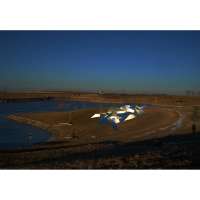Through my work, I explore the concept of how external surroundings impact the “internal” experience of the individual and how dimensional transformation alters the function of a form. I utilize the duality of material surfaces to create undulating planes and sculptural layers of shadow, light, and form.
While extensively studying the works of the West Coast artists from the 1960s Light and Space movement and László Maholy Nagy’s kinetic Light Space Modulator, I considered the abstracted incorporation of mathematical principles in design. I gravitated towards the concept of the Möbius strip because I felt that the continuous flow demonstrated by the single-surfaced, non-orientable entity could be crucial to better understanding the phenomenological experience of a space. My earlier work focused on designs in which there was a sense of flow with regard to the structure of a space; floors becoming walls, walls then turning to form a ceiling; how a purposeful and dimensional transformation alters the function of a form. By considering how origami expresses and utilizes the duality of a paper’s inner and outer surface in the context of the Möbius strip, I began creating architectonic forms. I felt that these sculptures called for the viewer to question their personal perception of reality- If a surface has the ability to possess multiple identities because it can perform different functions simultaneously, how do we classify it in relation to our previous understanding of spatial relationships acquired through both individual experience and collective memory?
Based upon the above, I’ve developed a landscape sculpture entitled “Illum”. The sculpture has lower and upper layers composed of geometric shapes that together create a landscape. The undulated mirrored planes bring the outer environs into the heart of the piece through reflection, thus blurring the boundaries between the sculpture and its surroundings while reflecting the sculpture back within itself. Together, the angled surfaces of the metal, mirrored, and illuminated planes create fragmented images of reality; representative of how people take in their surroundings as fragments, and assemble them into a whole memory through interpretation. The sculpture itself is dynamic; the moving sun changes the angled shadows over the course of a day. By being illuminated from dusk to dawn, the piece transforms from an experience to a meditation on light.
Through my work, I explore the concept of how external surroundings impact the “internal” experience of the individual and how dimensional transformation alters the function of a form. I utilize the duality of material surfaces to create undulating planes and sculptural layers of shadow, light, and form.
While extensively studying the works of the West Coast artists from the 1960s Light and Space movement and László Maholy Nagy’s kinetic Light Space Modulator, I considered the abstracted incorporation of mathematical principles in design. I gravitated towards the concept of the Möbius strip because I felt that the continuous flow demonstrated by the single-surfaced, non-orientable entity could be crucial to better understanding the phenomenological experience of a space. My earlier work focused on designs in which there was a sense of flow with regard to the structure of a space; floors becoming walls, walls then turning to form a ceiling; how a purposeful and dimensional transformation alters the function of a form. By considering how origami expresses and utilizes the duality of a paper’s inner and outer surface in the context of the Möbius strip, I began creating architectonic forms. I felt that these sculptures called for the viewer to question their personal perception of reality- If a surface has the ability to possess multiple identities because it can perform different functions simultaneously, how do we classify it in relation to our previous understanding of spatial relationships acquired through both individual experience and collective memory?
Based upon the above, I’ve developed a landscape sculpture entitled “Illum”. The sculpture has lower and upper layers composed of geometric shapes that together create a landscape. The undulated mirrored planes bring the outer environs into the heart of the piece through reflection, thus blurring the boundaries between the sculpture and its surroundings while reflecting the sculpture back within itself. Together, the angled surfaces of the metal, mirrored, and illuminated planes create fragmented images of reality; representative of how people take in their surroundings as fragments, and assemble them into a whole memory through interpretation. The sculpture itself is dynamic; the moving sun changes the angled shadows over the course of a day. By being illuminated from dusk to dawn, the piece transforms from an experience to a meditation on light.
